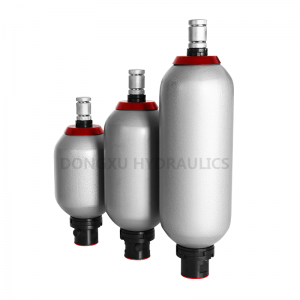The installation of the accumulator includes pre-installation inspection, installation, nitrogen filling, etc. Correct installation, fixation and inflation are important conditions for the normal operation of the accumulator and its proper function. The measurement of parameters and the correct use of various tools and meters cannot be ignored.
During the use of the accumulator, it needs to be anti-vibration, anti-high temperature, anti-pollution, anti-leakage, and the air bag should be checked regularly for air tightness and other aspects. Therefore, daily inspection and maintenance are indispensable. The daily inspection is to check the appearance and status by simple methods such as visual, auditory, hand touch and instrumentation. During the inspection, it is necessary to check not only the part but also the overall equipment. For the abnormal conditions found during the inspection, those that hinder the accumulator from continuing to work should be dealt with urgently; for others, they should be carefully observed and recorded, and resolved during regular maintenance. Some damaged parts also need to be replaced in time. Active maintenance is a new concept that has been proposed internationally in recent years after breakdown maintenance, preventive maintenance, and condition maintenance.
A new device management theory. Its definition is: to repair the root parameters that lead to equipment damage, so as to effectively prevent the occurrence of failure and prolong the service life of the equipment. Proactive maintenance is to take measures to address the root cause of the equipment before it wears out, effectively controlling the occurrence of wear and failure, thereby greatly extending the repair cycle. Active maintenance not only guarantees the reliable operation of hydraulic equipment and components, but also greatly reduces maintenance costs. The accumulator is a dangerous part in the hydraulic system, so special attention should be paid to safety during operation. Accumulator fault diagnosis and elimination include not only the diagnosis and elimination of the accumulator itself, but also the fault diagnosis and elimination of the hydraulic system where the accumulator is located, and the two are intertwined. The main tasks of fault diagnosis are:
(1) Determine the nature and severity of the fault. According to the site conditions, judge whether there is a fault, what is the nature of the problem (pressure, speed, action or other), and the severity of the problem (normal, minor fault, general fault, or serious fault).
(2) Find the failed component and the location of the failure. According to the symptoms and related information, find out the point of failure for further troubleshooting. Here we mainly find out “where is the problem”.
(3) Further search for the initial cause of the failure. Such as hydraulic oil pollution, low component reliability, and environmental factors that do not meet the requirements. Here mainly to find out the external cause of the failure.
(4) Mechanism analysis. Carry out in-depth analysis and discussion on the causal relationship chain of the fault, and find out the ins and outs of the problem.
(5) Predict the development trend of faults. Predict the future condition of the accumulator or hydraulic system based on the status and speed of system wear and degradation, theoretical and empirical data of component service life. Analyze, compare, count, summarize and synthesize to find out the rules.
Post time: Aug-19-2023
